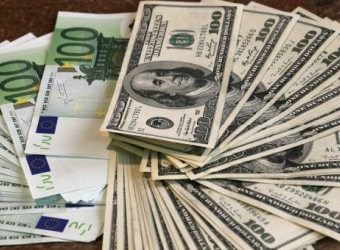The dollar wallowed at one-year lows against the euro and slipped against sterling in Asian trade on Thursday as investors priced in tighter monetary policy in Europe.
The dollar index, which tracks the greenback against a basket of six major rival currencies, was down 0.1 percent at 95.843, plumbing its lowest levels since October and well below highs above 97.0 hit earlier this week.
Sterling added to gains made after Bank of England Governor Mark Carney said on Wednesday that the central bank is likely to need to raise interest rates as the British economy comes closer to operating at full capacity.
European Central Bank President Mario Draghi sparked the euro’s rally on Tuesday, when he hinted that the ECB could trim its stimulus this year. The Federal Reserve hiked interest rates this month and left the door open for further increases later in the year, though a batch of mixed economic data recently has had investors wondering whether the Fed would be able to stay on its planned tightening path.
The Federal Reserve hiked interest rates this month and left the door open for further increases later in the year, though a batch of mixed economic data recently has had investors wondering whether the Fed would be able to stay on its planned tightening path.
The dollar’s decline “is broadly due to the re-evaluation by market participants of the relative speed of the central banks to take away easing,” said Bill Northey, chief investment officer at U.S. Bancorp Wealth Management in Helena, Montana.
“The ECB and the BoE might be moving more rapidly than before, and stubbornly low inflation in the U.S. might lead the Fed to revaluate its pace as well,” he said.
The euro was up 0.3 percent at $1.1410 after scaling a peak of $1.1420, despite evidence that positioning for a dramatic scaling-back of stimulus might have been overdone.
Draghi’s remarks were intended to signal tolerance for a period of weaker inflation, not an imminent policy tightening, and set up September as the earliest the bank would discuss rolling back stimulus, according to sources familiar with the ECB chief’s thinking.
The pound was up 0.2 percent at $1.2955 after rising to $1.2977 earlier, its highest since June 9.
The BoE’s Monetary Policy Committee were split 5-3 earlier this month on whether to raise British interest rates from their record-low 0.25 percent.
By contrast, Bank of Japan policymakers believed their best approach would be to maintain their current ultra-loose policy, with inflation well shy of their 2 percent target, according to a summary of the BOJ’s latest meeting issued on Monday.
The divergent monetary policy outlooks helped bolster the dollar against the yen, but it still edged down 0.1 percent to 112.28 after rising as high as 112.495 earlier in the session, its highest since May 17.
The euro was up 0.2 percent at 128.08 yen. Earlier, it rose as high as 128.13 yen.
The Australian dollar rose 0.2 percent to $0.7656 after earlier touching $0.7664, its highest since late March.
“It looks to me as if the Aussie’s benefiting from a softer dollar, but also the bounce in commodities,” said Mitul Kotecha, head of Asia macro strategy for Barclays in Singapore.
“Iron ore in particular has rallied, and it seems to be giving some pretty good support to the Aussie dollar,” Kotecha said.
Iron ore prices continued their rise after rallying more than 3 percent on Wednesday.
Source: Reuters


